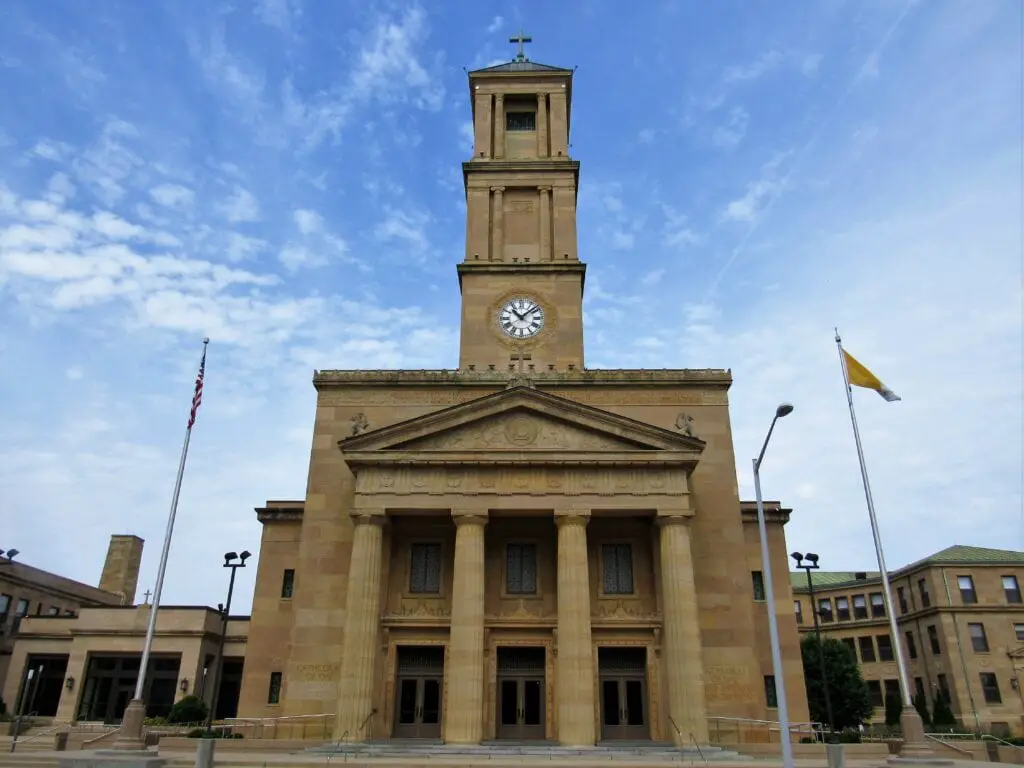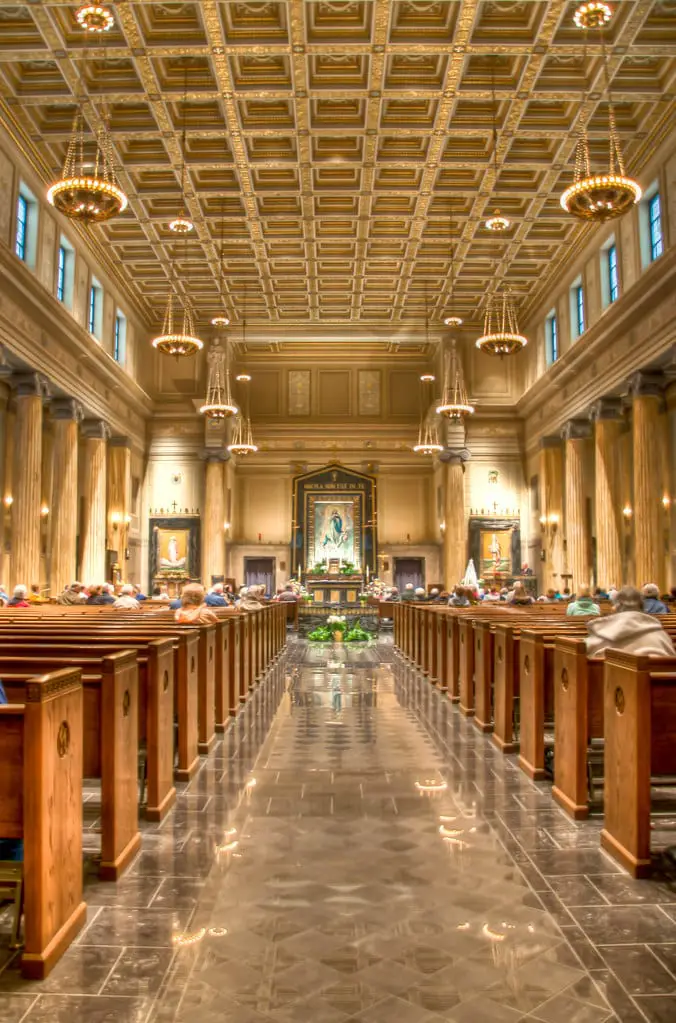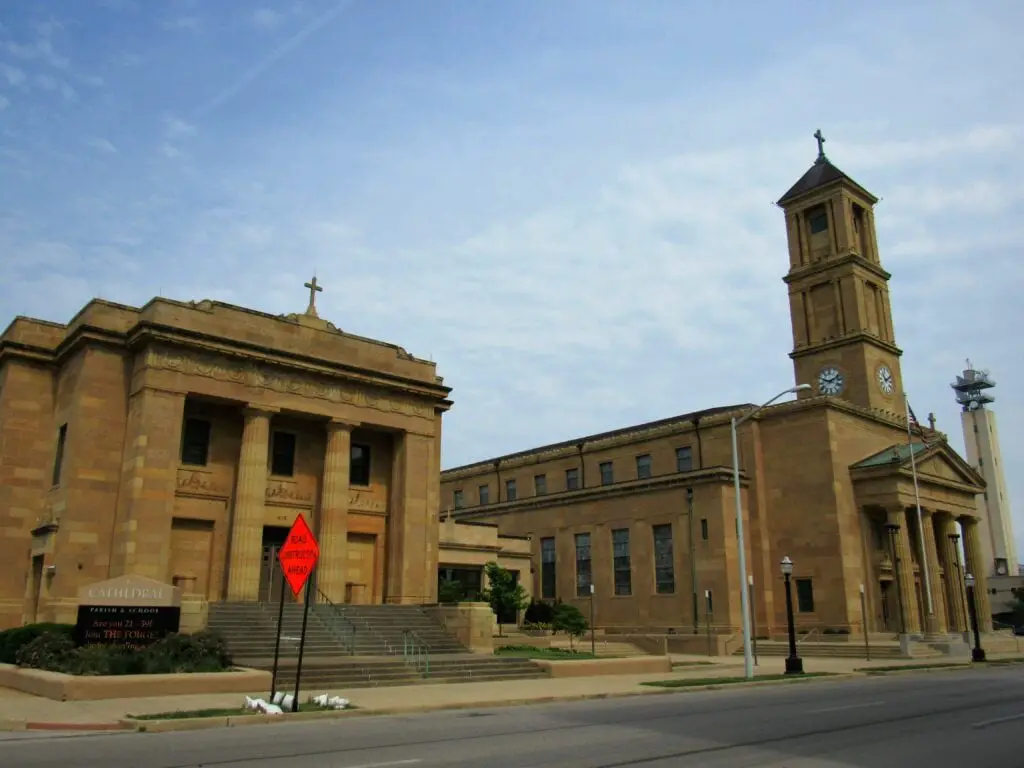Cathedral of the Immaculate Conception: The Early Beginnings
Imagine stepping back in time to the bustling town of Springfield, Illinois, in the mid-19th century.
The year is 1859, and the newly built English-speaking church dedicated to the Immaculate Conception is a shining beacon of faith for the ever-growing congregation.
This church, affectionately known as Old St. Mary's, was a place of worship and a beacon of faith to the English-speaking members of the parish, while the German-speaking members held onto the old frame church.
Just a year later, the congregation had grown so much that an addition was added.
A gallery was set back over the entrance, the floor was lowered by three feet, and the front of the church was extended by twenty feet.
The church was a place of worship and a center for learning.
In 1860, a school was opened for the parish boys, with the Holy Cross Brothers from Notre Dame, Indiana, in charge.
A Cathedral Takes Shape
Fast forward to 1923, and a significant event would forever change the landscape of Springfield's religious community.
On October 26 of that year, Pope Pius XI issued a Papal bull, transferring the Episcopal See from Alton to Springfield.
This decree designated the Church of the Immaculate Conception as the new Cathedral of the Immaculate Conception.
The following year, George Cardinal Mundelein ordained the Most Reverend James A. Griffin, a priest of the Archdiocese of Chicago, as the first bishop of Springfield in Illinois.
Under his guidance, the first stone of the new Cathedral was positioned on August 14, 1927, and the consecration of the Cathedral of the Immaculate Conception took place on October 14, 1928.
Built in a modified Greek Revival architectural style, this Cathedral was a testament to the growing Catholic community in Springfield.
The Cathedral Today
Today, the Cathedral of the Immaculate Conception is a prominent landmark in Springfield.
The cathedral complex, faced with Kasota limestone, a golden limestone quarried in Mankato, Minnesota, is home to the Catholic Diocese of Springfield in Illinois.
But it's not just a place of worship - the cathedral complex also contains working space for the bishop and staff, and an elementary school building forms the southern component of the complex.
The Cathedral of the Immaculate Conception is more than just a building.
It symbolizes faith and devotion, where the Christian faithful gather to pray, worship, and celebrate their faith.
It's a testament to the resilience and perseverance of the Catholic community in Springfield.

A Time for Reflection and Celebration
As we reflect on the history of the Cathedral of the Immaculate Conception, it's impossible not to feel a sense of awe and wonder.
This Cathedral, which has stood the test of time, is a living testament to the faith and dedication of the Catholic community in Springfield.
From its early beginnings as a small church in the mid-19th century to its designation as a cathedral in the 20th century, the Cathedral of the Immaculate Conception has been a beacon of faith and a symbol of resilience and perseverance.
In recognition of the 100th anniversary of the translation of the seat of the Diocese of Alton to Springfield, the Apostolic Penitentiary, by the power of the faculties granted to it by Pope Francis, kindly gives a plenary indulgence to the Christian faithful, from December 8, 2022, until December 9, 2023.

This indulgence is granted under the usual conditions of sacramental Confession, Eucharistic Communion, and prayers for the intention of the Supreme Pontiff, for the faithful who are truly penitent and compelled by love.
This indulgence can be applied by the faithful for the souls in Purgatory.
One way to do this is by visiting either the Cathedral of Springfield in Illinois or the Church of Ss.
Peter and Paul in Alton.
These visits should be made as a pilgrimage and include attending the jubilee rites.
Alternatively, the faithful can devote a suitable amount of time for pious reflections on the Diocese's faithfulness to the Christian vocation.
This period of reflection should conclude with the recitation of the Lord's Prayer and the Symbol of Faith, also known as the Creed.

Lastly, the indulgence process for the souls in Purgatory concludes with prayers directed towards the Immaculate Conception of the Most Blessed Virgin Mary and Ss.
Peter and Paul.
Through the efforts of the devoted clergy and the faithful, the Cathedral of the Immaculate Conception continues to flourish and inspire the Christian community in Springfield and beyond.
It remains a testament to the dedication of those who built it, the devotion of those who worship within its walls, and the enduring faith that it represents.
As the Cathedral enters its second century, it continues to serve as a beacon of hope, guidance, and community, illuminating the path for future generations of the faithful.

